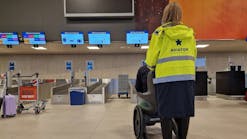Finding Your Way Around Flow Monitoring
By Zach Varwig
“What’s the most stressful part of your journey?” SITA asked travelers in 2012. Nearly a third of respondents answered that the security process was the greatest cause of stress, followed by 16 percent with flight transfer, and 12 percent with the check-in and bag-drop process. Not unexpectedly, when asked what are your main causes of stress during travel, loss of time ranked first with 44 percent of respondents.
What is it that an airport can do to ease the traveler experience and make it more enjoyable? Addressing these key areas identified by SITA is a logical start for any airport looking to enhance its passenger service.
Mitigating the stress of travel isn’t simply a matter of improving the check-in and security process. It’s also about putting useful information in the hands of the passenger, before he/she even leaves for the airport. What are the conditions now? What are they projected to be? How long are the lines at TSA? How long are the lines to check bags at their airline? What’s the total travel time, from my front door to the gate?
These questions have answers. All of this information can be collected and distributed to travelers, using a range of different devices, systems and communication mediums.
Information Collection
Camera Analytics
Airports have been using CCTV camera systems for decades to support security, safety and operations personnel in assessing conditions. As these systems have grown in use, they have shifted focus from a security-centric deployment to an airport-wide operational tool. Among the many uses of an enterprise surveillance system like this are flow monitoring of passengers and queue line analytics. Using the existing camera infrastructure, along with the deployment of queue management software, airports can manage, measure and count passengers moving through the checkpoint. Some software even incorporates predictive analytics, providing a future snapshot of passenger volume based upon current wait times and historical statistics.
This system relies upon a pre-existing camera infrastructure, and is primarily meant for queue areas. However, it does provide one of the highest levels of accuracy versus other solutions, making it a favorite option for many European airports. Dulles International Airport is currently the only major U.S. airport with a camera analytics program of this type, though this is expected to change in the near term (a link to the site is displayed later in this article).
Wi-Fi Enabled Devices
Wi-Fi location determination has been developed in recent years, offering Wi-Fi enabled devices positioning capability. SITA reports that in 2012 70 percent of travelers carried smart phones when traveling. Leveraging the existing Wi-Fi infrastructure, Wi-Fi enabled smart phones can be used to monitor passenger dwell time and movements throughout the airport. This information is then displayed in real time, or logged for historical analysis by airport officials. This information can then be used to direct the flow of passengers, shift employees to improve efficiency of security or immigration checkpoints and improve the design of wayfinding throughout the airport. The location services used through Wi-Fi may require an upgrade to many existing Wi-Fi infrastructures, along with purchase of an RTLS server if not already installed.
Wi-Fi passenger flow monitoring systems are currently installed at many tier one airports, with growing interest from many airports worldwide.
Bluetooth
Already more established than the Wi-Fi antenna model, Bluetooth tracking uses distributed Bluetooth antennas at either end of the airport queues to assess wait times through a certain area. The Bluetooth antennas recognize devices with their Bluetooth turned on and in discoverable mode. While many people have devices with Bluetooth capability, only 5-8 percent of people typically have a device that is enabled, providing the system with a small but usable sample size.
Tampa International Airport, George Bush Intercontinental Airport and Indianapolis International Airport have all tested this technology in their facility. For those worried about mobile security, the Bluetooth data from traveler’s smart phones is encrypted for security and never shared. While a major drawback of this technology is its inability to distinguish between individual queue lines, Bluetooth sensors, when deployed correctly, can be dialed down to measure the wait times by queue lane.
Information Distribution
After collecting the data, the information should be distributed to the passenger or airport stakeholder. Several methods exist to support the dissemination of information.
Airport Dynamic Signage
Airport signage, either dedicated use (flight information or advertising) or shared use, is the most common means of wait time distribution. Airports can display wait times at different checkpoints, providing information to passengers on which checkpoint will yield a quicker throughput. This helps ease the burden on airport operators, who now need less staff to direct passengers to the most efficient checkpoints.
This means of communication is the most widely used and is very effective in communicating the information to passenger and airport staff in the immediate area, within check-in or security.
Dedicated Airport App
A growing trend is the development of an airport specific mobile application. While there are many different business opportunities available through the development of mobile applications, one is the display of queue wait times, accessible through the app anywhere an internet connection is available. With wayfinding integration, not only can passengers check the amount of time it takes to get through the checkpoint before they even leave home, they can map their entire trip from their front door to parking to departure.
Providing a mobile application with wayfinding technology helps travelers plan their trip from start to finish, reducing their overall stress level. Portland International Airport recently deployed its own mobile application with wayfinding technology, powered by the type of Wi-Fi infrastructure mentioned above.
SMS/Text Message
One of the best things about SMS/Text message communication is nearly everyone has a phone capable of receiving these types of messages. Many passengers pre-register their phone number with airlines, allowing for the airlines to push data, such as flight delays and gate changes, over SMS messaging. If flight data is currently sent to travelers, why isn’t other information? Security and bag check queuing information could be distributed over wireless carriers' networks, to a list of passengers who pre-register on the system. Hartsfield-Jackson Atlanta International Airport’s Trak-a-Line system operates in this way.
Airport Website
Nearly all airports have their own dedicated websites, which are used as a tool to communicate information about the airport including operational data. Providing a link to the website of a dynamic map with checkpoint wait times allows travelers to access checkpoint data before they leave home, allowing for planning and preparation in the event of possible lines. Dulles International Airport offers this information on their website, and can be viewed here:
http://www.metwashairports.com/dulles/4793.htm
While the above uses are passenger facing, a lot of this information is valuable to airport operators. It provides real time forecasting and a definitive log of airport throughput, traffic and wait times. TSA can more accurately measure their wait times and staff accordingly, rather than rely on historical data based forecasting. This information, when tracked, can also be used to hold those accountable for holding up travelers at a facility.
With the continuing growth of the air travel industry comes the increase in time lost waiting in lines. Airports and airlines can improve customer satisfaction and service by collecting and distributing information as described here to provide a better, more efficient experience for passengers and airport operators alike.
Faith Group, LLC has worked with airports since 2004, helping them to choose, implement and manage solutions from concept development to implementation. If you have any questions regarding a solution for your facility, or any of the technologies or devices mentioned in this article, please email us at [email protected], or call 314-991-2228, and we would be happy to help you reach your goals.
Bibliography
SITA 2012 IT Trends Survey





